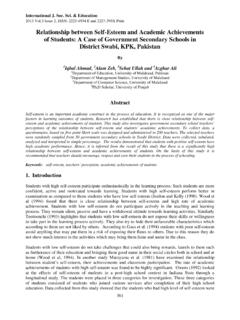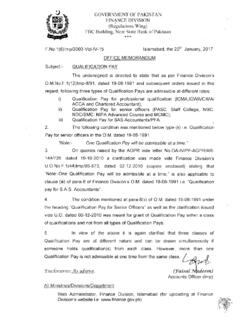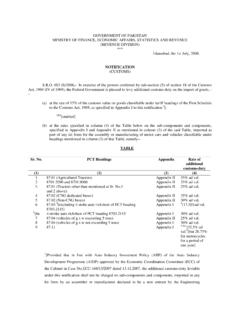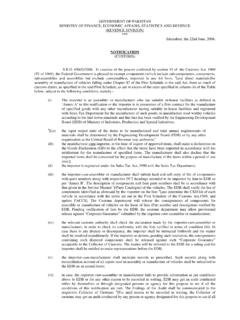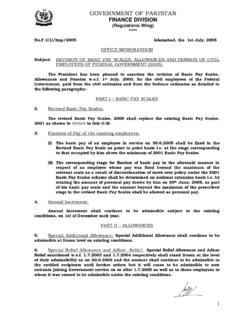Transcription of Secondary School Certificate Examination Syllabus
1 Secondary School Certificate Examination Syllabus HISTORY AND GEOGRAPHY of pakistan CLASSES IX-X (based on National Curriculum 1993) Published by Aga Khan University Examination Board Bungalow # 233 / , Daudpota Road, Karachi, pakistan . March 2005 Latest Revision June 2012 All rights reserved This Syllabus is developed by Aga Khan University Examination Board for distribution to all its affiliated schools. Secondary School Certificate Examination Syllabus HISTORY AND GEOGRAPHY of pakistan CLASSES IX-X This subject is examined in both May and September Examination sessions Latest Revision June 2012 Page 4 S. No. Table of Contents Page No. Preface 5 1. Aims/Objectives of the National Curriculum (1993) 7 2. Rationale of the AKU-EB Examination Syllabus 7 3. Topics and Student Learning Outcomes of the Examination Syllabus 10 4.
2 Scheme of Assessment 28 5. Teaching-Learning Approaches and Classroom Activities 31 6. Recommended Text and Reference Material 32 7. Definition of Cognitive Levels and Command Words 33 Annex: SSC Scheme of Studies 36 For queries and feedback Address: The Aga Khan University Examination Board Bungalow No. 233/ , Daudpota Road, Karachi- pakistan . Phone: (92-21) 35224702-10 Fax: (92-21) 35224711 E-mail: Website: Facebook: Latest Revision June 2012 Page 5 PREFACE In pursuance of National Education Policy (1998-2010), the Curriculum Wing of the Federal Ministry of Education has begun a process of curriculum reform to improve the quality of education through curriculum revision and textbook development (Preface, National Curriculum documents 2000 and 2002). AKU-EB was founded in August 2003 with the same aim of improving the quality of education nationwide.
3 As befits an Examination board it seeks to reinforce the National Curriculum revision through the development of appropriate examinations for the Secondary School Certificate (SSC) and Higher Secondary School Certificate (HSSC) based on the latest National Curriculum and subject Syllabus guidance. AKU-EB has a mandate by Ordinance CXIV of 2002 to offer such Examination services to English and Urdu medium candidates for SSC and HSSC from private schools anywhere in pakistan or abroad, and from government schools with the relevant permissions. It has been accorded this mandate to introduce a choice of Examination and associated educational approach for schools, thus fulfilling a key objective of the National Curriculum of pakistan : Autonomy will be given to the Examination Boards and Research and Development cells will be established in each Board to improve the system (ibid.)
4 Para. (ii)). AKU-EB is committed to creating continuity of educational experience and the best possible opportunities for its students. In consequence it offered HSSC for the first time in September, 2007 to coincide with the arrival of its first SSC students in college or higher Secondary School . Needless to say this is not an exclusive offer. Private candidates and students joining AKU-EB affiliated schools and colleges for HSSC Part 1 are eligible to register as AKU-EB candidates even though they have not hitherto been associated with AKU-EB. This Examination Syllabus exemplifies AKU-EB s commitment to national educational goals. It is in large part a reproduction, with some elaboration, of the Class IX and X National Curriculum of the subject. It makes the National Curriculum freely available to the general public. The Syllabus recommends a range of suitable textbooks already in print for student purchase and additional texts for the School library.
5 It identifies areas where teachers should work together to generate classroom activities and materials for their students as a step towards the introduction of multiple textbooks, another of the Ministry of Education s policy provisions for the improvement of Secondary education (ibid. para. ). Latest Revision June 2012 Page 6 This Examination Syllabus brings together all those cognitive outcomes of the National Curriculum statement which can be reliably and validly assessed. While the focus is on the cognitive domain, particular emphasis is given to the application of knowledge and understanding, a fundamental activity in fostering attitudes befitting useful and peaceful citizens and the skills for and commitment to lifelong learning which is the cornerstone of national economic development (Preface to National Curriculum documents 2000 and 2002).
6 To achieve this end AKU-EB has brought together university academics, teacher trainers, writers of learning materials and above all, experienced teachers, in regular workshops and subject panel meetings. AKU-EB provides copies of the Examination Syllabus to subject teachers in affiliated schools to help them in planning their teaching. It is the Syllabus , not the prescribed text book which is the basis of AKU-EB examinations. In addition, the AKU-EB Examination Syllabus can be used to identify the training needs of subject teachers and to develop learning support materials for students. Involving classroom teachers in these activities is an important part of the AKU-EB strategy for improving the quality of learning in schools. The Curriculum Wing of the Federal Ministry of Education has recently released new subject specifications and schemes of study to take effect in September, 2008.
7 These documents are a major step forward towards a standards-related curriculum and have been welcomed by AKU-EB. Our current SSC syllabuses have been revised to ensure conformity with the new National Curriculum 2006. We stand committed to all students entering the SSC course as well as those who have recently embarked upon the HSSC course in facilitating their learning outcome. Our Examination Syllabus document ensures all possible support. Dr. Thomas Christie Director, Aga Khan University Examination Board July 2009 Latest Revision June 2012 Page 7 1. Aims/Objectives of the National Curriculum (1993)1 The National Curriculum for History and Geography of pakistan outlines the following aims and objectives: Objectives 1. To develop an understanding of the Geography of pakistan and its scope to those students who are studying it in lieu of Urdu.
8 2. To develop analytical skill among students for understanding the man- environment inter-action in pakistan . 3. To promote sense of appreciation among the students, of the geographical problems of pakistan . 4. To create interest in the subject by using reference material, audiovisual Aids, documentaries, photographs etc. 2. Rationale of the AKU-EB Examination Syllabus General Rationale In 2007, the Curriculum Wing of the Federal Ministry of Education (MoE) issued a revised part-wise Scheme of Studies. All subjects are to be taught and examined in both classes IX and X. It is therefore important for teachers, students, parents and other stakeholders to know: (a) that the AKU-EB Scheme of Studies for its SSC Examination (Annex) derives directly from the 2007 Ministry of Education Scheme of Studies; (b) which topics will be examined in Class IX and in Class X; (c) at which cognitive level or levels (Knowledge, Understanding, Application and other higher order skills) the topics and sub-topics will be taught and examined; This AKU-EB Examination Syllabus addresses these concerns.
9 Without such guidance teachers and students have little option other than following a single textbook to prepare for an external Examination . The result is a culture of rote memorization as the preferred method of Examination preparation. The pedagogically desirable objectives of the National Curriculum which encourage observation, creativity and other higher order thinking skills are generally ignored. AKU-EB recommends that teachers and students use multiple teaching-learning resources for achieving the specific objectives of the National Curriculum reproduced in the AKU-EB Examination syllabuses. Latest Revision June 2012 Page 8 The AKU-EB Examination syllabuses use a uniform layout for all subjects to make them easier for teachers to follow. Blank sheets are provided in each Syllabus for writing notes on potential lesson plans.
10 It is expected that this arrangement will also be found helpful by teachers in developing classroom assessments as well as by question setters preparing material for the AKU-EB external examinations. The AKU-EB aims to enhance the quality of education through improved classroom practices and improved examinations. The Student Learning Outcomes (SLOs) in Section 3 start with command words such as list, describe, relate, explain, etc. The purpose of the command words is to direct the attention of teachers and students to specific tasks that candidates following the AKU-EB Examination syllabuses are expected to undertake in the course of their subject studies. The Examination questions will be framed using the same command words or the connotation of the command words to elicit evidence of these competencies in candidates responses.




